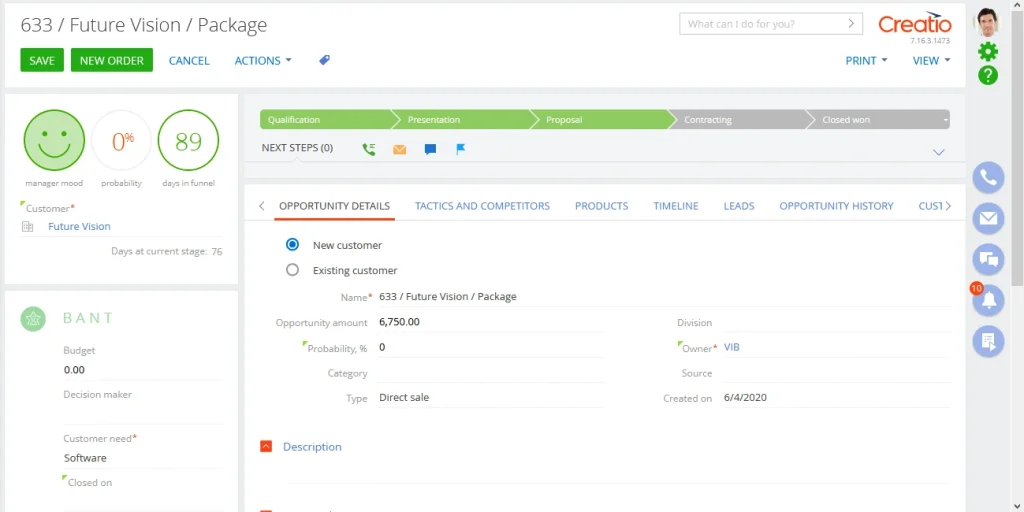How digital transformation has evolved in 2025
Companies are obliged to make their business become more digitally oriented to keep up with the pace of technology and high customer expectations. Making a digital transformation can affect many aspects. Work efficiency can increase, security for internal and external purposes is strengthened, and so on. Plus, digital transformation can boost the brand’s image toward the key customer groups and help them quickly recognize the brand.
The digital transformation process may vary, yet there are 3 key universal characteristics:
- Digital transformation modernizes existing technologies to help businesses achieve greater agility.
- Upgraded digital systems can improve the collaboration flow between business and IT.
- With digital transformation, companies can generate more innovation in a shorter period, prompting higher efficiency.
As you can see, applying digital transformation is not solely about implementing tech but also putting best practices and talents at all levels of a company’s operation. Nowadays, companies have 3 approaches to unlock digital maturity:
| Off-the-shells products | Building from scratch (Traditional development) | Using low-code for digital transformation | |
|---|---|---|---|
| Pros | – Use instantly after purchasing – Cost-saving – No need to code and extensive training – Has been validated and tested by other users – Automatically updates | – Build as you wish – Match your business model and project requirement – High flexibility and centralization – Can be scaled and upgraded for cross-department use – No vendor lock-in | – Faster than traditional development, while allowing customization unlike off-the-shells products. – Scalable, flexible and secure – Cost-effective – Citizen developers and business users can also build apps without coding expertise |
| Cons | – Only solve one problem and serve one group of users – Limited in scalability – Limited in integration, security and customization – Can’t 100% match your expectation and requirements – Risk of vendor lock-in – Risk of shadow IT | – Time-consuming – High costs – Require professional technicians – You are the first one to use the application, so there’s no validation before – Risk of the application being unable to used | – Requires internal training for all employees to use – Risk of vendor lock-in – Risk of shadow IT |
Key takeaway
With all the mentioned benefits, low-code emerges as a feasible solution and can outweigh other digital transformation methods. It’s more cost-effective and faster than the traditional method while better than off-the-shells products in scalability and customization. Especially when companies are urging for tech to improve performance, but their resources can’t match the high demand.
Continue to read with Synodus to understand what low-code is and in what case it drives digital transformation better than others.
A brief intro to the low-code alternatives
Businesses that have already been successful in digital transformation (either using off-the-shells software or building from scratch) are now turning to low-code development. Gartner predicts that in 2025, low-code will likely take up 65% of digital transformation activity.
Why is that?
Low-code is made of click-and-point configuration (where pre-built codes and designed elements can be dragged into places) and customization ability. Because of this, citizen developers can create simple applications to serve their needs. Meanwhile, professional coders can focus on customization to make the app fit the business model.

A good low-code platform for digital transformation should meet your business strategy and development methodology. We highly recommend using low-code with agile development, as the technology provides tools to benefit the process with ease. Of course, this doesn’t mean low-code won’t work with waterfall or other development methods. You need to set some regulations to combine the two seamlessly.
How low-code drives better digital transformation?
1. Speed and agility that are cost-effective
Low-code does not contain a complex architectural stack of traditional coding. Instead, it is replaced with a functional and visual building format. With such, developers of any level can create apps with low risk of bugs and reuse as many components as possible.
Given these two features, low-code requires less money and labor resources spent on digital transformation. This would eventually cut down app development time, quickly make necessary changes, and receive immediate feedback on projects.
2. Automate business processes
You can also build automation tools with low-code since most platforms have RPA abilities. Having a centralized workflow management tool is not only beneficial for managers but also boosts collaboration between teams and members. Anyone can access data and update on progress instantly. There are two simple ways to do this:
- You create a services worker to automate a single task, such as scanning documents, classifying raw data, identifying patterns in data, etc.
- Create single-department processes such as HR processes (onboarding/ offboarding, recruitment)
- Build cross-department to cross-functional processes, such as client order processing, client management (sending data between sales to customer services), CRM, ERP.
On top of that, low-code platforms integrate built-in security features, making them a reliable and secure solution to industries with high demand for data security like finance and healthcare.
Read on to learn about other use cases of using low-code for automation!
3. Meet your customer need faster with low-code digital transformation
In the end, digital transformation’s primary goal is to serve your customers by boosting speed in response with technology. This may sound cliché. But imagine how satisfying your customers would be if they received a package earlier than expected because you use low-code to build an automation system that cuts down time for manual tasks.
Low-code digital transformation platforms are the solution to this as they provide a flexible design for a better customer experience in general. Companies use low-code technology to reduce delivery timeframes to only hours, make real-time updates to data, and use customer feedback to refine existing applications.
Here’s what you can build to leverage the game for companies and their customers.
- AI Chatbot
- Customer analytics systems
- Automatic call routing
- Help desk tools
- Customer services application
- Sign-up web portal
- Self-services portal for customers
4. Tackle the dilemma: Buy or build

When it comes to building an app, businesses usually have two choices. They either build the app of their own or buy an off-the-shelf application.
By building a unique app by themselves, businesses might get a competitive advance against other opponents, yet the developing process usually takes time and effort. On the other hand, buying a pre-made app will shorten development time and cut down the budget, but it also limits the chance of customization and reduces uniqueness when compared with other competitors.
Therefore, a low-code digital transformation platform is a balanced mix of the abovementioned solutions. Using low-code, enterprises can create customized apps without starting from scratch. Also, low-code platform contains many robust, ready-to-use functionalities, ensuring the application’s security, scalability, and flexibility.
5. Enable greater CI/CD
Thanks to the minimal coding features, business users can now develop apps faster in rapid time sequences and experiment without an overspending budget. Low-code can also quickly connect in-house legacy and internal systems so businesses can rapidly make decisions and gain real-time business insights.
Not only that, but enterprises can also utilize low-code digital transformation platforms for complex apps while still supporting simpler apps. This would create a parallel and fair approach toward business applications.
Successful use cases of using low-code for digital transformation
Toyota Motor North America (TMNA) overcame the adversity of digital transformation during Covid-19 by using the Microsoft Power Platform. Their team created various mobile apps for multiple purposes (internal and external) and brought developers from all levels to achieve their goals while contributing to tech creation.
Low-code platform Creatio has revolutionized Namu Travel Group – an expert network specializing in boutique vacations. Using the technology, Namu has integrated advanced applications into their existing systems: Opportunity assigner, event tracking, and profiling. This resulted in lower customer funnel time and improvement in agent productivity;
And yes, low-code can cut down paper-based processes and optimize automation in the working process. In 2014, Coca-Cola United initiated franchising to expand its sales. With the integration of the low-code platform, the IT and Logistics team shortened their workload while handling more orders from more channels.
Top low-code digital transformation platforms to use
With so many choices in the market, here’re some of our top recommendations. Depending on your requirements and needs, the best-suited low-code platforms should be able to improve your problematic areas.

- Power Apps for internal tools and automation development. Power Apps low-code platform for digital transformation solution is suitable for businesses of all sizes to build professional-grade apps. Being a Microsoft product, it can also be directly embedded in your Office365, Teams, and SharePoint management system, creating a synchronized tool across the board. Learn how this commercial bank from the Netherlands accelerates its performance with Power Apps internal process automation!
- Creatio for CRM and app development. Starting as a CRM provider, Creatio deeply grabbed how the technology should work to drive values in sales and customer management. Because of this, their low-code platform is filled with various features helping businesses tailor their sales and marketing-related systems.
- Salesforce Lightning for mobile app development. Being a leading contender for low-code in mobile app development, Salesforce provides interactive design elements and robust back-end code for you to effectively create mobile apps for your end-users.
Of course, there are others emerging low-code platforms for digital transformation as well. If you want to learn the good, the bad, and the ugly of them, we also have reviewed the top 25 platforms!
On the other hand, low-code isn’t just drag-and-drop like we think it is. To leverage the best of each platform, customization is a great add-up.
If you are looking for a hand in Custom Low-code Development Service, Synodus is the gold partner of Power Apps and Salesforce. Our well-versed experts provide in-depth consultation, seamless execution and training across board, ensuring your application can drive value to your digital transformation journey! View our portfolio and Share your ideas with our team!
Digital transformation with low-code is good but not always 100%

Despite the benefits of low- code, some downsides hinder it from being the optimal choice for digital transformation.
- Vendor Lock-in Risks: When choosing low-code automation, most businesses must rely solely on the vendor that they have chosen. Some vendors limit the capabilities that users can use on their service and even stop allowing changes in the application after users stop using it. This can be complicated for businesses when they want to change their vendor;
- Probability of Shadow IT: This usually happens when an individual or a department uses unauthorized low-code digital transformation tools for any reason. Users in these situations often get exposed to unexpected risks and waste resources, potentially putting projects on hold;
- Overlooked Complexity of Low-code: Low-code digital transformation platforms might be considered as a simpler alternative, yet it still requires a basic understanding of code to function. Low-code is less complicated than hand-coding, but it won’t hurt if users know how to handle some programming languages.
Check out our guide: 4 Step To Set Up Low-code Governance That Kills Shadow IT
Wrapping up
Low-code is an ideal option for digital transformation as it improves the speed of the development cycle, automates business processes, and saves the budget for enterprises while making more room for experiments. Ideal as it sounds, businesses should consider low-code digital transformation before choosing it as the final solution.
More related posts from Low-code blog you shouldn’t skip:
- Low-code For Cloud Development: Can They Go Hand-In-Hand?
- 9 Low-code Internal Tools To Step Up Your Performance
- 7 Top Choices Of Low-code Platforms For On-premises Application
- Using Low-code For IoT Development: Opportunity & Barriers
How useful was this post?
Click on a star to rate it!
Average rating / 5. Vote count:
No votes so far! Be the first to rate this post.




